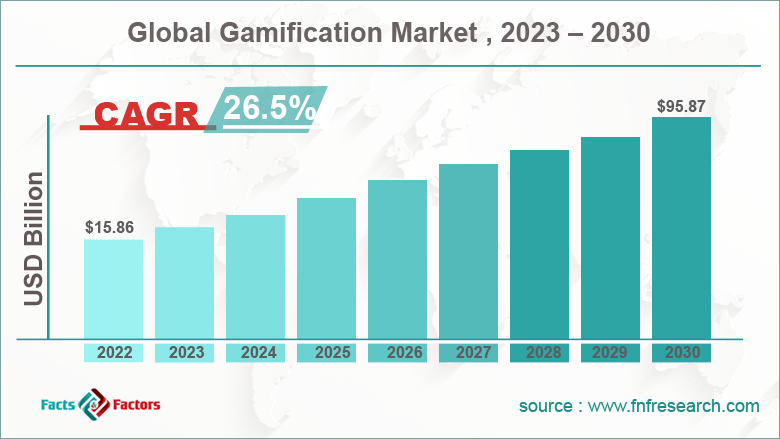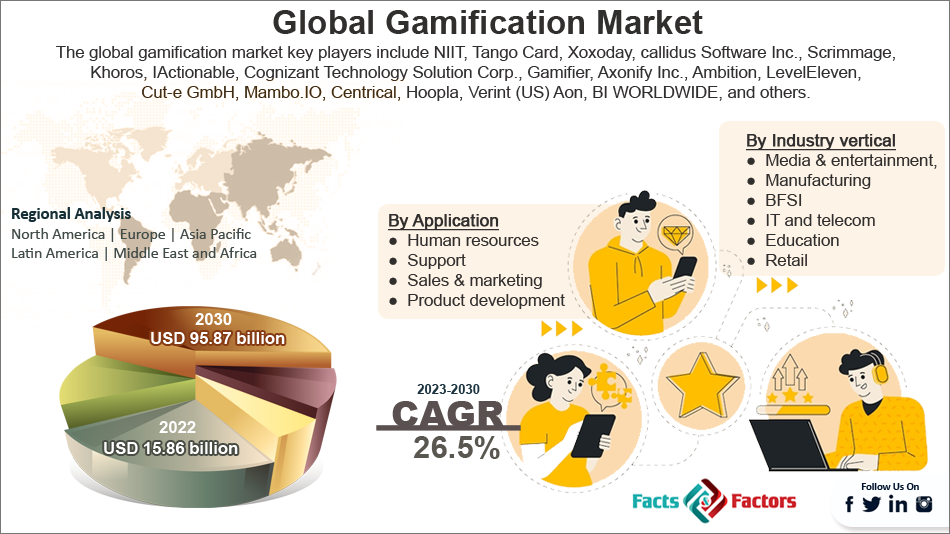Search Market Research Report
Gamification Market Size, Share Global Analysis Report, 2023 – 2030

Gamification Market Size, Share, Growth Analysis Report By Enterprise Size (SMEs, Large Enterprises), By Component (Service, Solution), By Deployment Model (Cloud, On Premise), By Application (Human Resources, Support, Sales & Marketing, Product development, Others), by Industry Vertical (Media & Entertainment, Manufacturing, BFSI, IT & Telecom, Education, Retail, Others), and By Region - Global and Regional Industry Insights, Overview, Comprehensive Analysis, Trends, Statistical Research, Market Intelligence, Historical Data and Forecast 2023 – 2030
Industry Insights
[221+ Page Report] According to the report published by Facts & Factors, the global gamification market size was valued at around USD 15.86 billion in 2022 and is expected to grow to USD 95.87 billion by 2030 with an increasing CAGR of 26.5% during the forecast period. The report on the global gamification market covers all aspects, including the potential growth drivers, restraints, and leading market players. Also, it offers detailed key insights into the opportunities and challenges in the market environment. The report also explores market segmentation and regional developments in the gamification industry.

 Market Overview
Market Overview
Gamification is the implementation of gaming principles and design elements in a non-gaming environment to engage people. Gaming has been used for different non-gaming aspects, like entertainment and educational purposes for a very long time. Leaderboards, badges, and points are a few of the most used gaming elements in the market. Businesses are increasingly deploying gaming principles in their organizations to accelerate the productivity of their staff, train employees, recruit manpower, and evaluate the organization's progress.
Furthermore, gamification is widely used in the market to increase user engagement, especially for tasks that seem boring to users but are of great importance to the company. It yields a greater ROI to companies.
 Key Insights
Key Insights
- As per the analysis shared by our research analyst, the global gamification market is estimated to grow annually at a CAGR of around 26.5% over the forecast period (2023-2030).
- In terms of revenue, the global market size was valued at around USD 15.86 billion in 2022 and is projected to reach USD 95.87 billion by 2030.
- The high adoption rate of AI is likely to boost the gamification market growth.
- Based on the enterprise size, the large enterprise segment accounts for the largest share of the global market.
- Based on the component, the solutions are the fastest-growing segment in the global market.
- Based on the deployment mode, the cloud segment holds the largest share of the global market.
- Based on the application, the sales & marketing segment accounts for the largest share of the global market.
- Based on the industry vertical, the retail segment holds the largest share of the global market.
- Based on region, North America is expected to dominate the market during the forecast period.

 Growth Drivers
Growth Drivers
- The increasing use of artificial intelligence (AI) is likely to drive the market's growth.
There is growing adoption of AI-based gaming solutions in the market globally. Big organizations are increasingly using edge cutting technologies and sophisticated AI solutions to have detailed data on employees' and users' activities. AI-based solutions help organizations to encourage employees to achieve their targets efficiently. Also, it helps organizations to find appropriate solutions by having clear motives for employees with the help of AI-based solutions.
For instance, Cisco gamified its social media education program for training purposes. And around 650 employees of the company completed the 13000 certified courses successfully. Working with such sizeable trained employees will positively impact the company's growth. Therefore, several companies are investing in AI-based solutions.
Additionally, gamification promotes transparency and collaborative culture among the employees in the organizations, which is another key reason for the growth of the global gamification market.
Furthermore, many capitalist companies are investing in SaaS platforms to offer AI-based gaming solutions, which will also fuel market growth in the coming years. For example, Inventus Capital India and Ideaspring Capital invested in the leading SaaS organization Worxogo Solutions Pvt. Ltd., which provides AI solutions to improve sales productivity.
 Restraints
Restraints
- Low output is likely to hinder the growth of the global market.
Gamification requires high skilled man force to meet the requirement of leading organizations. However, the low output rate due to the high complexity is hampering the growth of the global gamification market.
 Opportunities
Opportunities
- The emergence of augmented reality (AR) and virtual reality (VR) is likely to offer lucrative opportunities.
The increasing investment in AR and VR technologies by world-leading organizations will leverage the opportunities in the global gamification industry. For instance, leading shopping giants like Walmart and Amazon are investing heavily in AR, VR, and other mixed technology to leverage the shopping experience and revolutionize the online marketing sector.
However, the integration of these immersive technologies with gamification will improve the customer engagement rate and thereby yield high ROI to the companies.
 Challenges
Challenges
- Poor programming and design skills are major challenges in the global market.
Gamification comes with multiple challenges, like narrative challenges, integration issues, complexity challenges, and many others. Gamification goes with several operational restrictions that limit the design of the games. Therefore, this makes gamification a more complex subject matter, and thereby, it requires advanced programming and designing skills in the industry.
However, the lack of highly skilled man force in the industry poses a major challenge in the global gamification market. Additionally, there is a much larger concern except for the lack of skills, which is the integration of gamified elements in the existing platforms and processes that slows down the growth rate.
 Segmentation Analysis
Segmentation Analysis
The global gamification market can be segmented on the basis of enterprise size, component, deployment mode, application, industry vertical, and region.
On the basis of enterprise size, the market can be bifurcated into small and medium enterprises (SMEs) and large enterprises. Among these, the large enterprises segment accounts for the largest share of the global market because these are the early adopters of gamification solutions and software in the market. Also, large enterprises are actively investing in advanced cloud-based gamified solutions to monitor employees and handle the workforce.
However, SMEs are also gaining momentum due to the growing competition in the market. Customer satisfaction is the key reason for the growing competition in the market.
On the basis of components, the market can be segmented into services and solutions. However, the solutions are the fastest-growing segment in the global market.
On the basis of deployment mode, the market can be categorized into cloud and on-premise segments. The cloud segment holds the largest share in the global market due to its rising demand owing to its high reliability and security aspects.
On the basis of application, the market can be segmented into human resources, support, sales & marketing, product development, and others. The sales & marketing segment accounts for the largest share of the global market because it helps companies increase productivity, sales, and engagement rates.
On the basis of industry vertical, the market can be segmented into media & entertainment, manufacturing, BFSI, IT and telecom, education, retail, and others. The retail segment holds the largest share of the global market due to the high implementation rate of gamification.
 Recent Developments:
Recent Developments:
- Microsoft integrated Dynamics 365 with new applications and features using AI-driven insights in September 2019 to help organizations make informed decisions and enhance customer experience.
- SAP acquired Qualtrics in January 2019 to offer advanced brand, product, employee, and customer experience.
 Report Scope
Report Scope
Report Attribute |
Details |
Market Size in 2022 |
USD 15.86 Billion |
Projected Market Size in 2030 |
USD 95.87 Billion |
CAGR Growth Rate |
26.5% CAGR |
Base Year |
2022 |
Forecast Years |
2023-2030 |
Key Market Players |
NIIT, Tango Card, Xoxoday, callidus Software Inc., Scrimmage, Khoros, IActionable, Cognizant Technology Solution Corp., Gamifier, Axonify Inc., Ambition, LevelEleven, Influitive, MPS Interactive Systems, Cut-e GmbH, Mambo.IO, Centrical, Hoopla, Verint (US) Aon, BI WORLDWIDE, and others. |
Key Segment |
By Enterprise Size, Component, Deployment mode, Application, Industry vertical, and Region |
Major Regions Covered |
North America, Europe, Asia Pacific, Latin America, and the Middle East &, Africa |
Purchase Options |
Request customized purchase options to meet your research needs. Explore purchase options |
 Regional Analysis
Regional Analysis
- North America to lead the global market in years to come
North America accounts for the largest share of the global gamification market due to the growing demand for well-customized solutions and sophisticated communication networks across enterprises. Additionally, the early adopters of gamification in the region further support the growth of the regional market.
Asia Pacific is likely to witness a high growth rate during the forecast period due to the emergence of several E-commerce websites in the region. Furthermore, the growing investment by big tech companies due to the presence of highly skilled workforces in the region will also promote the growth of the regional market during the forecast period.
 Competitive Analysis
Competitive Analysis
- NIIT
- Tango Card
- Xoxoday
- callidus Software Inc.
- Scrimmage
- Khoros
- IActionable
- Cognizant Technology Solution Corp.
- Gamifier
- Axonify Inc.
- Ambition
- LevelEleven
- Influitive
- MPS Interactive Systems
- Cut-e GmbH
- Mambo.IO
- Centrical
- Hoopla
- Verint (US) Aon
- BI WORLDWIDE
The global gamification market is segmented as follows:
 By Enterprise Size Segment Analysis
By Enterprise Size Segment Analysis
- SMEs
- Large enterprises
 By Component Segment Analysis
By Component Segment Analysis
- Services
- Solutions
 By Deployment Mode Segment Analysis
By Deployment Mode Segment Analysis
- Cloud
- On-premise
 By Application Segment Analysis
By Application Segment Analysis
- Human resources
- Support
- Sales & Marketing
- Product development
 By Industry Vertical Segment Analysis
By Industry Vertical Segment Analysis
- Media & entertainment,
- Manufacturing
- BFSI
- IT and telecom
- Education
- Retail
 By Regional Segment Analysis
By Regional Segment Analysis
- North America
- The U.S.
- Canada
- Mexico
- Europe
- France
- The UK
- Spain
- Germany
- Italy
- Nordic Countries
- Denmark
- Sweden
- Norway
- Benelux Union
- Belgium
- The Netherlands
- Luxembourg
- Rest of Europe
- Asia Pacific
- China
- Japan
- India
- Australia
- South Korea
- Southeast Asia
- Indonesia
- Thailand
- Malaysia
- Singapore
- Rest of Southeast Asia
- Rest of Asia Pacific
- The Middle East & Africa
- Saudi Arabia
- UAE
- Egypt
- South Africa
- Rest of the Middle East & Africa
- Latin America
- Brazil
- Argentina
- Rest of Latin America
Industry Major Market Players
- NIIT
- Tango Card
- Xoxoday
- callidus Software Inc.
- Scrimmage
- Khoros
- IActionable
- Cognizant Technology Solution Corp.
- Gamifier
- Axonify Inc.
- Ambition
- LevelEleven
- Influitive
- MPS Interactive Systems
- Cut-e GmbH
- Mambo.IO
- Centrical
- Hoopla
- Verint (US) Aon
- BI WORLDWIDE
Frequently Asked Questions

Copyright © 2025 - 2026, All Rights Reserved, Facts and Factors


